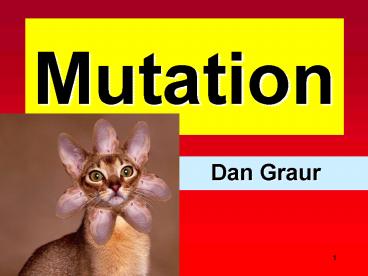Mutation - PowerPoint PPT Presentation
1 / 59
Title:
Mutation
Description:
Mutations can occur in either somatic or germline cells. ... Vole. Barn swallow. mutation rate. mutation rate. fitness. fitness. 44. Spatial Distribution ... – PowerPoint PPT presentation
Number of Views:1172
Avg rating:3.0/5.0
Title: Mutation
1
Mutation
- Dan Graur
2
DNA sequences are usually copied exactly during
DNA replication. Rarely, however, errors occur,
giving rise to novel sequences. These errors are
called mutations.
3
Mutations can occur in either somatic or germline
cells. Somatic mutations are not inherited in
animals.
4
Plants do not have a sequestered germline and,
therefore, the distinction between somatic and
germline mutations is not absolute.
5
(No Transcript)
6
Mutations create new genetic variation
7
Substitution
Point
Deletion
Mutations
Insertion
Substantive
Segmental
Inversion
Contextual
Recombination
8
transition
substitutions
transversion
recombination
deletion
insertion
inversion
9
(No Transcript)
10
synonymous
nonsynonymous
nonsense
11
(No Transcript)
12
(No Transcript)
13
Codons that can mutate to a termination codon by
a single nucleotide substitution, e.g., UGC
(Tyr), are called pretermination codons.
14
Mutations in stop codons causing the translation
to continue are called sense mutations.
15
Each sense codon can mutate to nine other codons
by means of a single nucleotide substitution.
Example CCU (Pro) can experience six
nonsynonymous substitutions, to UCU (Ser), ACU
(Thr), GCU (Ala), CUU (Leu), CAU (His), or CGU
(Arg), and three synonymous substitutions, to
CCC, CCA, or CCG.
16
Since the standard genetic code consists of 61
sense codons, there are 61 ? 9 549 possible
nucleotide substitutions.
17
(No Transcript)
18
Recombination
19
(No Transcript)
20
reciprocal
21
non- reciprocal
22
Reciprocal recombination is a powerful generator
of variability. For example, recombinations
between 5AACT3 and 5CTTG3 may result in 6
novel sequences 5ATTG3 5CACT3
5AATG3 5CTCT3 5AACG3 5
CTTT3
23
The more variants there are, the more variants
will come into being through recombination, and
the rate of generating new genetic variation will
become quite high. Variation begets
variation. Golding and Strobeck (1983)
24
Insertion Deletion
25
Insertion
Insertion
Unequal Crossing Over
26
Intrastrand Deletion
27
Frameshifts
28
When two sequences are compared, it is impossible
to tell whether a deletion has occurred in one or
an insertion has occurred in the other.
INsertions and DELetions are collectively
referred to as INDELs.
29
The number of nucleotides in an indel range from
one or a few nucleotides to contiguous stretches
of thousands of nucleotides.
30
Indel lengths exhibit a bimodal frequency
distribution, with short indels (up to 2030
nucleotides) being caused by errors of DNA
replication, such as slipped-strand mispairing,
and with long indels occurring mainly because of
unequal crossing-over, site-specific
recombination, DNA transposition, or horizontal
gene transfer.
31
Inversion
(a) chromosome breakage and rejoining (b)
intrachromosomal crossing-over between two
homologous segments that are oriented in opposite
directions
32
Mutations affect the genotype. Mutations may or
may not affect the phenotype. A strict
unambiguous correspondence between genotype and
phenotype does not exist.
33
The phenotype may be affected by factors other
than the genotype. If it does, the organism is
said to possess phenotypic plasticity.
34
The phenotypic response of a genotype to an
environmental factor is called the reaction
norm.
35
(No Transcript)
36
(No Transcript)
37
Mutation rates
Direct estimates
Problem Mutations rates are too low to measure
directly. Solution I Increase rate.
38
(No Transcript)
39
(No Transcript)
40
(No Transcript)
41
Mutation rates
Direct estimates
42
Mean mutation rate in mammalian nuclear DNA is 3
to 5 ??109 nucleotide substitutions per
nucleotide site per year. Mean mutation rate in
mammalian mitochondria is 5 ??108 nucleotide
substitutions per nucleotide site per year.
Mean mutation rate in influenza A and Moloney
murine sarcoma virus is 102 mutations per
nucleotide site per year. Mutation rates vary
enormously with genomic region.
43
mutation rate
fitness
Vole
fitness
mutation rate
Chernobyl
Barn swallow
44
Spatial Distribution of Mutations
45
Mutations do not occur randomly throughout the
genome. Some regions are hotspots of mutation.
One such hotspot is the dinucleotide 5'?CG?3'
(CpG), in which the cytosine is frequently
methylated in many animal genomes, and may mutate
to 5'?TG?3'.
46
Mutations do not occur randomly throughout the
genome. Some regions are hotspots of mutation.
The dinucleotide 5'?TT?3' is a hotspot of
mutation in many prokaryotes, but not in
eukaryotes.
47
Palindromes
48
Molecular palindrome
49
Patterns of Mutation
50
The direction of mutation is nonrandom.
Transitions occur more frequently than
transversions. In animal nuclear DNA, transitions
account for 70 of all mutations (expected
proportion under random mutation 33). In
animal mitochondrial genomes, the ratio of
transitions to transversions is about 20. In
grasshoppers the ratio of transitions to
transversions is 1. Some nucleotides are more
mutable than others. For example, in nuclear DNA
of mammals, G and C tend to mutate more
frequently than A and T.
Podisma pedestris
51
Mutations are commonly said to occur randomly.
However, mutations do not occur at random with
respect to (1) genomic location, (2)
environmental conditions, (3) nor do all types of
mutations occur with equal frequency. So, what
aspect of mutation is random?
52
(No Transcript)
53
(No Transcript)
54
Fluctuation test. Salvadore Luria and Max
Delbrück. 1943.
55
Replica plating. Ester and Joshua Lederberg. 1952.
56
A mutation is expected to occur with the same
frequency under conditions in which it confers an
advantage on the organism carrying it, as under
conditions in which it confers no advantage or is
deleterious. It is a deplorable imperfection
of nature that mutability is not restricted to
changes that enhance the adeptness of their
carriers. Theodosius Dobzhansky (1970)
57
Selection driven (Lamarckian) mutations?
58
Vorträge über Descendenztheorie
59
The Mutation Balancing Act Too few mutations ?
No evolution Too many mutations ? No life































